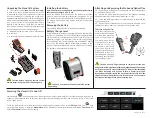
3. Diving with Galileo
62
3. Diving with Galileo
3.6.3 PDIS during dives with MB
levels
When diving with MB levels, PDIS follows
the same rules as described above. MB
levels, however, introduce stops earlier
and deeper than the L0 base algorithm. As
such, the PDIS display may be delayed and
for certain dives it may not be displayed at
all. This for instance would be the case for a
shallow dive with air (21% oxygen) and MB
level L5.
3.7 Altitude and the
decompression algorithm
Atmospheric pressure is a function of
altitude and of weather conditions. This
is an important aspect to consider for
diving, because the atmospheric pressure
surrounding you has an influence on on-
gassing and off-gassing of nitrogen. Above
a certain altitude, the decompression
algorithm has to change in order to account
for the effect of the change in atmospheric
pressure.
Galileo divides the possible altitude range
in 5 classes:
- class 0 (not indicated on the computer
display): from sea level to approximately
1,000m/3,300ft (switch point at
905mbar);
- class 1: from approximately
1,000m/3,300ft to approximately
2,000m/6,600ft (switch point at
815mbar);
- class 2: from approximately
2,000m/6,600ft to approximately
3,000m/1,0000ft (switch point at
725mbar);
- class 3: from approximately
3,000m/10,000ft to approximately
4,000m/13,300ft (switch point at
610mbar);
- class 4: above approximately
4,000m/13,300ft. In this altitude class
Galileo functions in gauge mode only
(automatic switch from computer
mode).
The altitude classes are defined in terms of
approximate elevations because the effect
of weather conditions can make the switch
point pressure occur at different levels.
4000 m
13120ft
2000 m
6560ft
1000 m
3280ft
3000 m
9840ft
0 m
No deco data
gauge mode
Switch point at 610 mbar / 8,85 psi
Switch point at 725 mbar / 10,51 psi
Switch point at 815 mbar / 11,82 psi
Switch point at 905 mbar / 13,82 psi
Galileo deals with altitude automatically: it
monitors the atmospheric pressure every
60 seconds, even when it is turned off, and
if it detects a sufficient drop in pressure, it
does the following:
- it switches on (if it was off);
- it indicates the new altitude range by
means of black segments inside the
stylized mountain and, if applicable, the
prohibited altitude range;
- it indicates the desaturation time, which
in this case is an adaptation time to
the new ambient pressure. If a dive
is started during this adaptation time,
Galileo considers it a repetitive dive,
since the body has residual nitrogen.
Summary of Contents for galileo luna
Page 1: ...English English ...
Page 2: ......













































